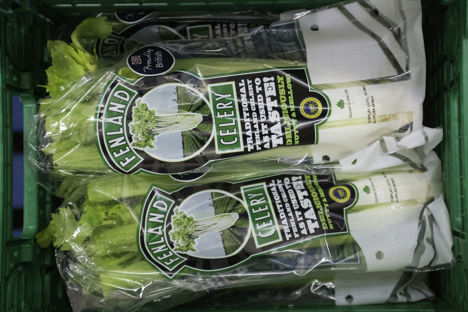
Super stalks: British Fenland Celery PGI
Fenland winter celery was once the pride of British Christmas tables – now it's making a comeback.
Super stalks: British Fenland Celery PGI
Fenland winter celery was once the pride of British Christmas tables – now it's making a comeback.
Winter celery, white celery, dirty celery, Fenland celery – all names for one of Britain’s most prized crops; a sweet, tender type of heritage celery, grown in the rich, dark, peaty Fenlands of Cambridgeshire, Norfolk and Suffolk. This seasonal winter delicacy, raised from heirloom seeds, was all but wiped out in recent years by modern varieties that could be grown densely packed into fields and harvested by machine. As with so many supermarket vegetables, texture and taste lost out to higher yields, uniform shape and durability in transport.
Traditionally, celery is grown in a similar fashion to Yorkshire forced rhubarb, another British artisan crop, with the sun kept off the stalks so they stay pale and tender. Where rhubarb spends months in pitch black sheds and is, romantically, harvested by candlelight, Fenland celery has earth piled high around it. In both cases the result is sweeter, more delicate stalks, with a beautiful colour and fantastic crunch.
Where modern celery sits in the ground for only two to three months (if it isn’t grown hydroponically), Fenland celery takes nearly five months to mature – with all the sunshine and rainfall that comes with it, absorbing nutrition from the highly fertile earth. Once an oak forest, then a bog, before becoming flooded and rotting down, the moist, black soils of the Fens are incredibly rich in organic matter – up to fifteen times more than other arable land.
The labour involved in producing Fenland celery is something to be celebrated – almost all of its life cycle it is tended by hand. Hands press the seedlings into the soft earth; hands pluck out the weeds that also grow voraciously in the healthy, vibrant soil. Machinery built seventy years ago banks earth around the plant as it grows, only now pulled by a tractor instead of a horse.
Each plant is pulled by hand; tough outer stalks are trimmed off with the slash of a knife and the delicious, dense root shaped into Fenland celery’s characteristic point. Not to be discarded, many consider this pointed root and the heart that stretches up out of it to be the very best part of the vegetable – amazing in a hearty braise. To avoid fights over the prized centre, fresh celery is often served sliced right down the middle, then again into quarters, so everyone gets their fair share.
Fenland celery used to be known as ‘dirty celery’, as thorough cleaning was required to remove the earth banked up around it. But now Fenland celery comes tidied up – carefully cleaned and dried by hand, of course, out there in the damp, peaty field.
This vegetable’s artisan production methods, the result of a hundred and fifty years of accumulated expertise, have recently been awarded protected food status by the European Union – the first recognition of its kind for a British vegetable. The unique nature of the seeds, soil and climate, as well as the efforts of generations of farmers who have tended this difficult crop, were all acknowledged with the PGI classification. Britain has been slow to celebrate its national specialities, unlike other countries in continental Europe, but there is change in the air.
Winter celery is delicate, nutty and rounded, with complex layers of salty, bitter and sweet that are absent from modern varieties – watery it is not. Bright and refreshing, with a strong note of citrus, it adds depth to cooked dishes but truly shines when served raw. I like the Victorian way of serving celery, as part of the Christmas cheeseboard – in its own dedicated celery vase, so the sticks can be arranged with the pomp and ceremony they deserve, as well as get a welcome drink of water. As English food authority Jane Grigson said in Vegetables: ‘Enjoy it in its season. This is the Christmas celery, the real thing… Serve the best inner stalks standing in a glass jug or jar, with a large piece of farmhouse cheddar, plus biscuits, bread and salty farm butter. When Stilton is coming to an end, mash the last pieces with butter and serve with the celery.’
Traditionally grown celery can be stored through the whole winter, staying happily crunchy and delicious for up to five weeks out of the fridge if kept away from light. When days are dark, rainy and wintery, having a fresh, local vegetable that thrives deliciously in the cool British climate is a marvellous thing. Fenland celery will definitely be making an appearance on my Christmas table this year – braised in aromatic stock with a nutty crumble topping for the main event, and later, with the cheese, pride of place on the table in its own special pot.
Nancy Anne Harbord


